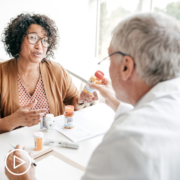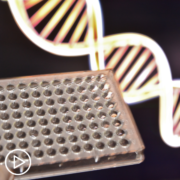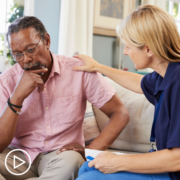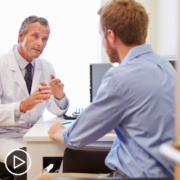Navigating Lung Cancer Treatment Decisions from Patient Empowerment Network on Vimeo.
What steps could help you and your doctor decide on the best treatment path for your individual disease? This animated video walks through key considerations, including molecular testing results, lifestyle factors and patient preference.
See More From the The Pro-Active Lung Cancer Patient Toolkit
Related Programs:
Transcript:
Hi, I’m Kendra. I’m a nurse practitioner and I specialize in lung cancer.
When diagnosed with lung cancer, it’s important to take steps to get a deeper understanding of your disease, and the available treatment options, so that you can feel confident in your care decisions.
Before we walk through the actions that can help you decide on a treatment path, I want to remind you that this video is intended to help educate lung cancer patients and their loved ones and shouldn’t be a replacement for advice from your doctor.
OK, let’s get started.
The first step is to understand your diagnosis—including the type of lung cancer and stage of disease—so that you can find out what treatments are available to you. Your physician will use tests, including biopsies and imaging, such as X-rays and CT scans, to ensure you have an accurate diagnosis.
The next step is to understand the approaches available for YOUR individual disease.
Depending on your stage and type of lung cancer, treatments can include:
- Surgery
- Radiation therapy
- Chemotherapy
- Targeted therapy or
- Immunotherapy
Or, you may receive a combination of one or more of these treatments.
Other testing that can impact your treatment options is molecular testing, which is used to identify specific mutations that are unique to your lung cancer. This may help in deciding if targeted therapies are an appropriate option for you.
Before you start any treatment, it’s essential to ask your doctor if you have had relevant molecular testing.
Another option that your physician may discuss with you is clinical trials, which may provide access to treatments that are not yet approved. At different points on your path with lung cancer, it’s important to talk with your doctor about whether there is a clinical trial that could be right for you.
Once you understand the treatments that are available to you, it’s time to talk to your doctor about the risks and benefits of each option and walk through the goals of your treatment.
One of the most important factors that your healthcare team will consider is YOUR treatment goals. Remember, you are a partner in your care and have an active voice in finding the best treatment for you. Physicians also typically consider a patient’s age, overall health, and existing conditions before they suggest a course.
So, what questions should you address when you are discussing your treatment goals with your doctor? Consider asking:
- Is the goal of the treatment to cure your disease or to obtain long-term control your disease?
- How effective will the treatment be and how will it impact your quality of life and lifestyle?
- What are the treatment side effects–both the short-term effects as well as long-term effects that may occur after you have completed treatment?
- Is there a member of the team, such as a social worker, that can help you understand the potential treatment costs? And is there access to financial resources that can help you if needed?
- Are there supportive care options that can help with symptoms and pain management at any stage of your cancer?
It also may be a good idea to consider a second, or even third opinion consultation with a specialist. And, if you don’t feel supported or you don’t feel heard by your healthcare team, then it is always best to get another opinion.
Finally, once you have gathered all the information, it may be helpful to talk it out with people you trust, such as a partner, friend or family member, to help you make a decision that you feel confident about.
Now, how can you put this information to work for you?
- Make sure you understand your type and stage of your lung cancer and the goals of your treatment options.
- Talk to your physician about what you’ve learned.
- Consider a consultation with a lung cancer specialist.
- Ask about molecular testing and what testing results mean for you.
- Discuss whether clinical trials are an option for your cancer.
- Visit credible online resources to stay up to date on lung cancer information.
- Visit powerfulpatients.org/lungcancer to learn more about lung cancer.





























